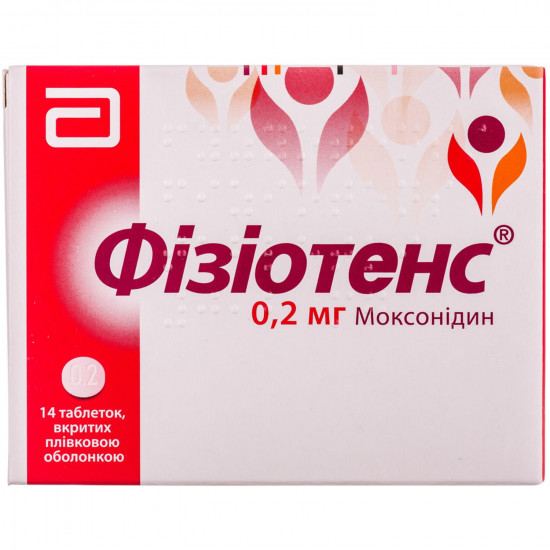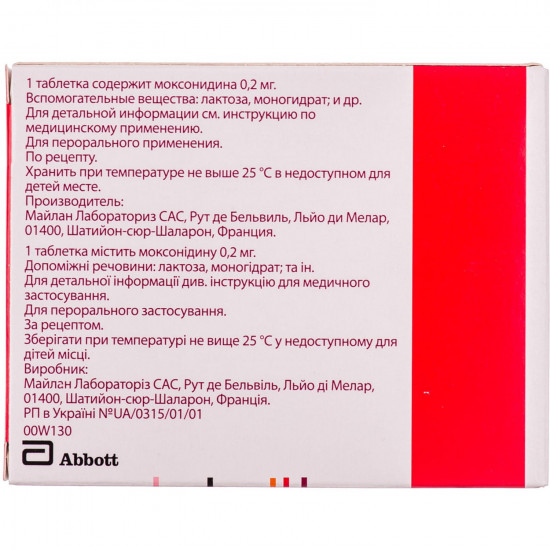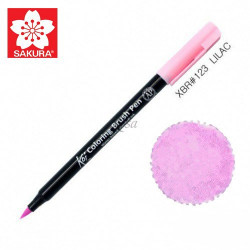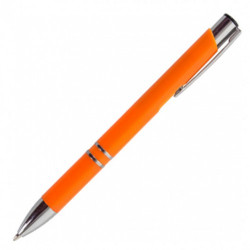



- Stock: In Stock
- Model: 185295
0% Customers recommend this product
-
5 Awesome0%
-
4 Great0%
-
3 Average0%
-
2 Bad0%
-
1 Poor0%
Reviews Over Fiziotens tab. of p/o of 0.2 mg No. 14
- (0)
Total Reviews (0)
click here write review to add review for this product.
Report this review.
Description
Pharmacological properties
Pharmacodynamics. it is proved what moksonidin is an effective antihypertensive agent. the available experimental data demonstrate that the place of antihypertensive action of a moksonidin — central nervous system. moksonidin — selection agonist of imidazolinovy receptors. these imidazolinchuvstvitelny receptors are concentrated in rostral department of a ventrolateralny part of a medulla — the site which is considered the center of regulation of peripheral sympathetic nervous system. stimulation of imidazolinovy receptors promotes decrease of the activity of sympathetic nervous system and lowers arterial blood pressure.
Moksonidin differs from other sympatholytic antihypertensive medicaments in rather low affinity to known α 2 - to adrenoceptors in comparison with imidazolinovy receptors. Thanks to it sedation and dryness in a mouth at use of a moksonidin arise seldom.
use of a moksonidin leadsAt the person to reduction of OPSS with the subsequent decrease in the ABP. The antihypertensive effect of a moksonidin is shown in double blind placebos - controlled randomized studies. The published data demonstrate that use of the antagonist of angiotensin II (AAII) together with moksonidiny at sick AG with a hypertrophy of a left ventricle at decrease in the AD identical level allowed to reach strengthening of regress of a hypertrophy of a left ventricle in comparison with a free combination of a tiazid and a blocker of calcium channels.
In therapeutic researches lasting 2 months in comparison with placebo moksonidin was increased by the index of sensitivity to insulin by 21% at patients with moderate AG, obesity and insulin resistance.
Pharmacokinetics. Absorption. After intake moksonidin quickly (time of achievement of the C max in blood plasma — about 1 h) is also almost completely absorbed in upper parts of a GIT. The absolute bioavailability is about 88% that indicates lack of considerable metabolism at primary passing through a liver. The concomitant use of food does not influence pharmacokinetics of a moksonidin.
Distribution. The extent of linking with proteins of blood plasma determined by in vitro makes about 7.2%.
Biotransformation. In samples of blood plasma of the person it is identified only degidrogenizirovanny moksonidin. The Pharmakodinamichesky activity of a degidrogenizirovanny moksonidin is near 1 / 10 activities of a moksonidin.
Removal. During the 24-hour period with urine 78% of the general dose of a moksonidin in the form of not changed connection and 13% are excreted — in the form of a degidrogenizirovanny moksonidin. Other insignificant metabolites in urine make about 8% of a dose. Less than 1% are removed with a stake. T ½ a moksonidin and its metabolite makes about 2.5 and 5 h respectively.
pharmacokinetics of a moksonidin significantly did not differ inAt sick AG in comparison with healthy faces.
At elderly people were noted by changes of pharmacokinetics, most likely, because of the reduced metabolic rate and/or a little bigger bioavailability. However these changes are not considered as clinically significant. As moksonidin it is not recommended by
to p for treatment of children, pharmacokinetic researches in this subpopulation were not conducted.
Removal of a moksonidin substantially depends on clearance of creatinine. At patients with a moderate renal failure (glomerular filtration rate — 30–60 ml/min.) stable concentration in blood plasma and T ½ approximately in 2 and 1.5 times is higher, than at patients with normal function of kidneys is (glomerular filtration rate of 90 ml/min.). Patients with a heavy renal failure have (glomerular filtration rate of 30 ml/min.) a stable concentration in blood plasma and T ½ is about 3 times higher. At these patients the accumulation of a moksonidin after reusable use is not revealed. At patients with a renal failure of an end-stage is (glomerular filtration rate of 10 ml/min.) which are on a hemodialysis, AUC in blood plasma and T ½ approximately in 6 and 4 times is higher respectively in comparison with hypertensive patients with normal function of kidneys. At patients with a moderate renal failure of the C max moksonidina in blood plasma is only 1.5-2 times higher.
based on the above-stated data, a dose of a moksonidin for patients with a renal failure it is necessary to select individually. During a hemodialysis moksonidin it is removed in insignificant degree.
Preclinical data on safety. In preclinical data the extra risk for the person on the basis of results of standard researches on pharmacological safety, chronic toxicity, genotoxicity, the cancerogenic potential and reproductive toxicity is not revealed. Researches on animals showed toxic impact on embryonic development at use of the doses toxic for a maternal organism. Researches of reproductive toxicity did not reveal influence on fertility and teratogenic potential. Toxic influence on embryonic development is noted at rats at doses ≥9 mg/kg/days and rabbits at doses higher than 0.7 mg/kg/days. During the researches peri- and post-natal development in rats noted influence on development and viability at doses of ≥3 mg/kg/days
Indication
Ag.
Use
Standard initial dose of a moksonidin makes 0.2 mg/days the maximum single dose — 0.4 mg. the maximum daily dose — 0.6 mg in 2 receptions. the dose should be selected individually, depending on reaction of the patient.
Fiziotens can be accepted irrespective of meal, washing down with a small amount of liquid.
For patients with a moderate or heavy renal failure the initial dose of a moksonidin makes 0.2 mg/days. In need of and in case of good tolerance of medicament the dose can be raised to 0.4 mg/days for patients with a moderate renal failure and to 0.3 mg/days for patients with a heavy renal failure (see. Special INSTRUCTIONS).
For the patients who are on a hemodialysis, the initial dose of the medicament Fiziotens makes 0.2 mg/days. In need of and in case of good tolerance of medicament the dose can be raised to 0.4 mg/days
Contraindication
Fiziotens is contraindicated at:
- hypersensitivity to active ingredient or any component of drug;
- sick sinus syndrome;
- bradycardia (at rest 50 ud. / mines);
- to AV blockade of II and III degree;
- heart failure.
Side effects
Most often side effects at reception of a moksonidin include dryness in a mouth, dizziness, an asthenia and drowsiness. the expressiveness of these symptoms often decreases after the first several weeks of treatment.
bygave the side reactions grouped in classes of systems of an organism and distributed on frequency noted in placebo Below - controlled clinical trials at 886 patients who applied moksonidin: very often (≥1/10), it is frequent (≥1/100, 1/10), infrequently (≥1/1000, 1/100).
from nervous system: often — a headache *, dizziness / vertigo, drowsiness; infrequently — obmorok*.
from a cardiovascular system: infrequently — bradycardia, hypotension * (including orthostatic hypotension).
from an organ of hearing and a labyrinth: infrequently — a ring in ears.
from a GIT: very often — dryness in a mouth; often — diarrhea, nausea/vomiting/dyspepsia.
from skin and hypodermic fabric: often — rash, an itching; infrequently — a Quincke's disease.
from a skeletal and muscular system and connective tissue: often — a dorsodynia; infrequently — neck pain.
from mentality: often — insomnia; infrequently — nervousness.
General disturbances and reactions in the injection site: often — an asthenia; infrequently — hypostasis.
* Frequency is not increased byin comparison with placebo.
toSpecial instructions
byDuring the post-registration period it was reported about cases of av-blockade of varying severity at the patients accepting moksonidin. therefore, it is impossible to exclude completely a causal role of a moksonidin in an av-conductivity delay. therefore it is recommended to be careful at treatment of patients with tendency to av-blockade development.
to Patients with AV blockade of the I degree should be applied moksonidin with extra care to avoid bradycardia. Moksonidin it is impossible to apply at patients with AV blockade of higher degree (see CONTRAINDICATIONS).
With care should be applied moksonidin at patients with a heavy ischemic heart disease or unstable stenocardia as experience of use of medicament for such patients is limited.
Is recommended to be applied with care moksonidin at patients with a renal failure as moksonidin it is allocated mainly with kidneys. Such patients are recommended to titrate carefully a dose, especially at the beginning of therapy. Treatment it is necessary to begin 0.2 mg/days with a dose; a dose it is possible to raise a maximum to 0.4 mg/days for patients with a moderate renal failure (glomerular filtration rate of 30 ml/min., but 60 ml/min.) and at most to 0.3 mg/days for patients with a heavy renal failure (glomerular filtration rate of 30 ml/min.) if it is clinically shown and medicament is transferred well.
If Fiziotens applyin a combination with a blocker of β-adrenoceptors and both medicaments need to be cancelled, at first it is necessary to cancel a blocker of β-adrenoceptors, and then in several days — Fiziotens.
were not noted Now by manifestations of effects of cancellation from the ABP after the termination of reception of a moksonidin. However the sudden termination of therapy moksonidiny is not recommended; instead the dose should be reduced gradually during 2 weeks
to Patients with single hereditary diseases, such as intolerance of a galactose, insufficiency of lactase or malabsorption of glucose galactose, it is not necessary to take this drug.
Ability to influence speed of response at control of vehicles or work with other mechanisms. Researches concerning influence of medicament on ability to run vehicles or to work with mechanisms did not carry out. It was reported about cases of drowsiness and dizziness at medicament use. It should be considered when performing of the specified actions.
Use during pregnancy or feeding by a breast
Pregnancy. There are no relevant data concerning use of a moksonidin for pregnant women. Researches on animals showed embriotoksichesky effect. The possible risk for the person is unknown. Moksonidin it is not necessary to apply during pregnancy if there is no obvious need.
Feeding by a breast. Moksonidin gets into breast milk therefore it should not be applied during feeding by a breast. If therapy moksonidiny is considered necessary absolutely, feeding by a breast should be stopped.
Children. Fiziotens it is not recommended for use for children because of insufficiency of data on safety and efficiency of medicament in this group.
Simultaneous use of medicament with other antihypertensive medicaments results
Interaction
in additive effect.As tricyclic antidepressants can reduce efficiency of antihypertensive medicaments of the central action, co-administration of these medicaments with Fiziotens is not recommended.
Moksonidin can enhance sedation of tricyclic antidepressants (co-administration should be avoided), tranquilizers, alcohol, sedative and sleeping medicines.
Moksonidin moderately increases disturbances of cognitive function at the patients receiving lorazepam. Moksonidin can enhance sedation of benzodiazepines at simultaneous use.
Moksonidin is brought byby tubular excretion. It is impossible to exclude interactions with other agents who are brought by tubular excretion.
Overdose
overdose Symptoms. in some cases the overdose of a moksonidin, even in the dose of 19.6 mg taken for 1 time did not lead to a lethal outcome. signs and symptoms of overdose include a headache, sedation, drowsiness, arterial hypotension, dizziness, an asthenia, bradycardia, dryness in a mouth, vomiting, fatigue, pain in upper area of a stomach. in case of heavy overdose the careful monitoring of disturbances of consciousness and respiratory depression is recommended. based on researches of use of high doses of medicament for animals, it is in addition possible to expect appearance of temporary hypertensia, tachycardia and hyperglycemia.
Necessary measures at overdose. Specific antidotes are unknown. In case of hypotension for support of haemo circulation the use of a dopamine and administration of plasma substituting solutions is recommended. At appearance of bradycardia it is possible to apply atropine.
Antagonists of α-adrenoceptors can reduce expressiveness or eliminate paradoxical hypertensive effects of overdose of a moksonidin.
Storage conditionsTablet of a fiziotens on 0.2 mg — to store
at a temperature not above 25 °C — to store tablets of a fiziotens on 0.3 and 0.4 mg at a temperature not above 30 °C. to store out of children's reach.
Prescription status: according to the prescription.
Specifications
| Characteristics | |
| Active ingredients | Moksonidin |
| Amount of active ingredient | 0.2 mg |
| Applicant | Abbott |
| Code of automatic telephone exchange | C02AC05 Moksonidin |
| Interaction with food | It doesn't matter |
| Light sensitivity | Not sensitive |
| Market status | Original |
| Origin | Chemical |
| Prescription status | According to the prescription |
| Primary packing | blister |
| Producer | MAYLAN LABORATORIES SAS |
| Quantity in packing | 14 tablets |
| Release form | tablets for internal use |
| Route of administration | Oral |
| Sign | Import |
| Storage temperature | from 5 °C to 25 °C |
| Trade name | Fiziotens |














































